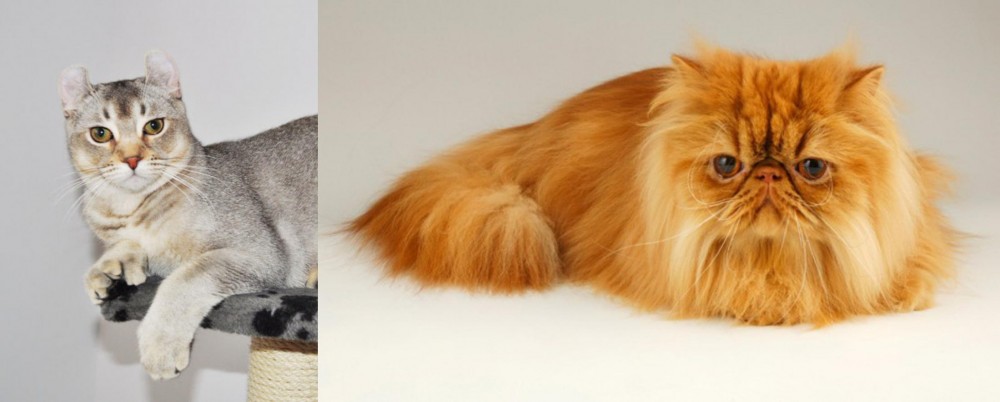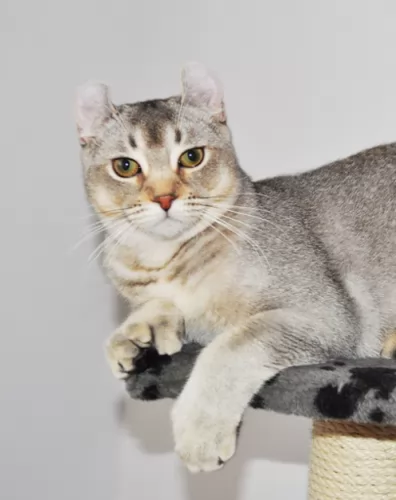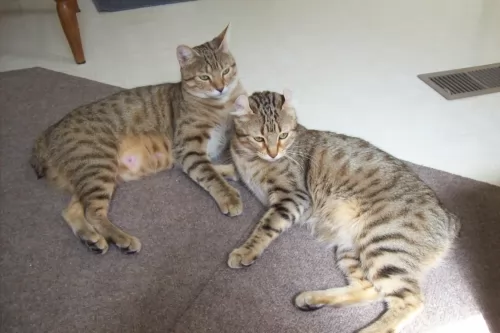 Petzlover
Petzlover Jungle-Curl is originated from United States but Persian is originated from Iran. Both Jungle-Curl and Persian are having almost same weight. Jungle-Curl may live 3 years more than Persian. Both Jungle-Curl and Persian has same litter size. Both Jungle-Curl and Persian requires Moderate Maintenance.
Jungle-Curl is originated from United States but Persian is originated from Iran. Both Jungle-Curl and Persian are having almost same weight. Jungle-Curl may live 3 years more than Persian. Both Jungle-Curl and Persian has same litter size. Both Jungle-Curl and Persian requires Moderate Maintenance.
 Originating from the United States, the Jungle Curl cat is a cross between the Jungle cat and the American Curl.
Originating from the United States, the Jungle Curl cat is a cross between the Jungle cat and the American Curl.
Several other spotted cat breeds have been used to bring about the cat such as the Bengal and the Egyptian Mau .
The Jungle Curl cat is a curled eared wild cat hybrid, though no one seems 100% sure about the different cats used to bring the cat about.
 Cat lovers the world over know the Persian cat very well. It's a beautiful long-haired cat breed with its familiar round face and blunt muzzle.
Cat lovers the world over know the Persian cat very well. It's a beautiful long-haired cat breed with its familiar round face and blunt muzzle.
It is not really known when long-haired cats first appeared, or where the Persian originated but their history stems from Persia or Iran as it is known today, where it seems they were first sighted.
The cats were grey-coated and some were white and soon the cats arrived in Britain. They were introduced to the United States in the 1900s. The cat was developed first by the English, and then also by American breeders after the Second World War and the breeding of these cats has also meant a lot of coat colors.
 It is a curled eared hybrid cat known for its long and lean frame. The hind legs are slightly longer than the front legs.
It is a curled eared hybrid cat known for its long and lean frame. The hind legs are slightly longer than the front legs.
The Jungle Curl’s tail may be medium-length or a full-length, and a bobtail isn't encouraged in this particular breed. An interesting fact with this cat is that extra toes - known as polydactyly, are a sought after characteristic.
The eyes of the cat are wide-set and slanted, and come in shades varying from gold to green.
The distinguishing characteristic of the Jungle Curl is the ears which curl away from the face. Some curls are more severe than others so the degree of the curl can vary from slight to more severe. The ears are somewhat smaller than average, and may be tufted.
The Jungle Curl may have long or short hair. Recognized coat patterns are tawny (ticked), leopard, and clouded leopard. Colors are silver, mink, lilac, fawn, chocolate, sorrel, blue, ebony, with the occasional red and cream.
The Jungle Curl loves exploring and is an energetic cat that is also friendly. Because they are active, they need lots of exercise along with stimulating activities such as toys that make them think as well as climbing apparatus.
People who have owned them as pets say they are dog-like and will love to splash around in water with their human owners and even fetch a ball.
Jungle Curls are more playful and exploratory than many domestic cats. People who have owned them say they have the intelligence and appearance of the wild cat, but the affection of a domestic cat.
These are cats that need a lot of attention. Keep toys and activities ready for this cat and ensure that you give him lots of attention.
The cats are dog-like which means you can even throw a small ball for it to retrieve.
 The Persian cat is a medium- to large-sized cat and is heavily boned. He can weigh between 3 and 6kg.
The Persian cat is a medium- to large-sized cat and is heavily boned. He can weigh between 3 and 6kg.
He has stocky legs, a thick neck, small ears, round head, round eyes, and the face is flat or blunt. The kittens are gorgeous balls of fluff.
The coat of the Persian is thick, long, and silky. People many times think only of a white Persian, when in fact the cat comes in many colors and patterns. Eye color for the cat can be blue, green, brown, copper or even odd-eyed.
The Persian isn’t the most active of cats, so attention will need to be given to exercising the cat so as to manage his weight. This cat will also need to have his nutrition controlled to stay in shape and in good health.
Persians enjoy games with their human family and will need some toys to encourage play and exercise.
He is placid and calm but that doesn’t mean he can’t have bursts of energy. They’re quieter than other cats, are sweet-natured, preferring to live in quieter, less boisterous households.
They aren’t loudly vocal but communicate with their eyes and their soft voices. They won’t get on well with small, noisy children but can be loving pets and companions of older children who allow them their own space.
 Allowing the private possession of cat hybrids like the Jungle Curl shouldn’t be allowed. It’s not that the Jungle Curl isn’t a wonderful cat – it is – but do research and you’ll find that these cats are always being rescued from animal sheltes because people dumped them there when they didn’t work out.
Allowing the private possession of cat hybrids like the Jungle Curl shouldn’t be allowed. It’s not that the Jungle Curl isn’t a wonderful cat – it is – but do research and you’ll find that these cats are always being rescued from animal sheltes because people dumped them there when they didn’t work out.
The Jungle Curl is an intelligent and affectionate cat, and people who have owned it will tell you that it is also one of these cats that become much like a dog in behavior.
It is energetic and playful and loves nothing more than to play with its owner. They love all the interaction and attention and don’t want to be left alone for too long as they become bored.
The Jungle Curl should have an outside cage when he is not being watched. You can even take him for walks. When he isn't being supervised, keep him safe in his outside cage. A hybrid cat needs special attention and a lot of exercise, and before you get one, think carefully.
 The amicable personality of the Persian cat makes it easy to have these cats in your home. The long hair becomes a bit of an issue as the cat sheds quite a bit.
The amicable personality of the Persian cat makes it easy to have these cats in your home. The long hair becomes a bit of an issue as the cat sheds quite a bit.
They’re sweet, quiet cats and they don’t demand attention from you. They are more than happy just lying quietly in a warm spot. They are calm, loving cats and it's no wonder that they are still such a popular breed of cat.
 These hybrids can also suffer from genetic defects that require particular, special diets. They sometimes require surgery because they can’t properly digest their food.
These hybrids can also suffer from genetic defects that require particular, special diets. They sometimes require surgery because they can’t properly digest their food.
The Jungle Curl is a loving, playful cat that will require a large outside enclosure if you want to ensure his good health. He isn't a cat to keep in a small apartment or constantly indoors.
These cats are susceptible to all of the same domestic cat diseases there are so you have to know of a good vet in your area who can see your cat when he is sick.
Speak to your vet about vaccines for the Jungle-Curl.
 The structure of this cat’s head can mean some health problems. Hereditary Polycystic kidney disease is prevalent with the Persian cat. It is an inherited condition that causes cysts to form in the kidneys. These cysts are actually present from birth, growing larger over time and interfering with kidney function and ending in kidney failure.
The structure of this cat’s head can mean some health problems. Hereditary Polycystic kidney disease is prevalent with the Persian cat. It is an inherited condition that causes cysts to form in the kidneys. These cysts are actually present from birth, growing larger over time and interfering with kidney function and ending in kidney failure.
Also, with a larger breed cat such as the Persian, hip dysplasia is a problem.
Persians are also susceptible to malocclusion which means ‘incorrect bite’. This particular condition can affect the cat’s ability to grasp and actually hold food. So much so in fact, that now pet food manufacturing companies have even developed specially-shaped kibble to cater particularly for the Persian.
 When feeding most hybrid cats protein is one of the most important factors. Also, make sure they get a good variety as well.
When feeding most hybrid cats protein is one of the most important factors. Also, make sure they get a good variety as well.
A cat such as the Jungle Curl will want a mix of meat such as chicken, beef, liver and salmon. Some of the excellent commercial cat foods are tremendously convenient, whether dry food, semi-wet or wet foods. There are sone excellent brands available that are high in protein.
Ensure a constant supply of fresh, cool water.
Supply your cat with all the things he needs to make his life happy. Water- and food bowls, nice warm bed, brush, grooming accessories, cat carrying box, litter box, and collar and tag.
Love your cat and pour your attention onto him.
 The Persian cat’s coat is long and silky and because he is a fairly heavy shedder, he will require regular brushing – certainly once or twice a week to get rid of that loose hair. It is important to brush and also cut the hair so as to get rid of the tangled knots that form.
The Persian cat’s coat is long and silky and because he is a fairly heavy shedder, he will require regular brushing – certainly once or twice a week to get rid of that loose hair. It is important to brush and also cut the hair so as to get rid of the tangled knots that form.
While brushing your Persian, make sure that his eyes and nose are clear. This is important because the flat face creates problems with these cats.
Excellent cat food for your Persian involves reading labels and understanding what brands are best for your beautiful cat. The Persian cat is a carnivore and will require high-quality food rich in protein.
Speak to your vet if you are in any doubt about the best food for your cat’s health and wellbeing. Make sure your pet has a constant supply of fresh, cool water.
Make sure to keep the litter box clean. Buy a small rake from the pet shop and rake up your cat's feces every single day and dispose of them.